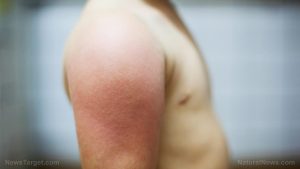
Erythema infectiosum – causes, side effects and treatments at NaturalPedia.com
Wednesday, March 21, 2018 by Ralph Flores
http://www.naturalpedia.com/erythema-infectiosum-causes-side-effects-and-treatments-at-naturalpedia-com.html

Erythema infectiosum, commonly known as the fifth disease, is a condition caused by the parvovirus B19. It mostly affects children, with its most recognizable characteristic is the development of a red rash on the face, particularly on the cheek, giving the impression of a “slapped cheek.” The rash can also appear in other parts of the body, such as the arms, legs, and trunk.
People who have erythema infectiosum are contagious before the onset of the rash. The virus can spread via droplets in the air that are transmitted by coughs and sneezes from the infected person.
Cases of erythema infectiosum usually last from one to three weeks in children; however, if the condition afflicts children older than 15 – including adults – symptoms can last for a few weeks to a couple of months, with some rare cases even having it for years. Once a person recovers from erythema infectiosum, however, lifelong immunity is guaranteed.
The illness was first described in 1896, with the name “fifth disease” coined afterward because of its position in an old classification of childhood illnesses which included measles (first disease), rubella (third disease), and roseola infantum (sixth disease).

Known risk factors and symptoms of erythema infectiosum
Erythema infectiosum usually occurs during the winter and spring season, as well as in areas with high concentrations of people – like schools. While a relatively healthy child will have no problems being exposed, those with compromised immune systems may potentially face a higher risk of a severe case. Moreover, if a pregnant woman is affected by the disease, she should seek medical care immediately as erythema infectiosum can adversely impact the fetus.
The signs and symptoms of erythema infectiosum are, at first, similar to those of mild flu or cold, which include:
- Low-grade fever
- A sore throat
- A headache
- Stuffy or a runny nose
- Fatigue
However, after a few days, the child will develop a bright red, raised rash on his or her face, which may spread to other areas of the body.
Body systems affected by erythema infectiosum
The disease primarily affects the skin in healthy children, but those who have red blood cell disorders (like sickle cell disease) or those with compromised immune systems may be affected differently, with the parvovirus B19 affecting the bone marrow and causing severe anemia.
Food items or nutrients that may prevent or relieve erythema infectiosum
Here are some recommended food items to help boost the immune system and manage symptoms of erythema infectiosum.
- Apple cider vinegar helps alkalize the body, allowing it to fight sickness and manage noticeable pain. Drinking a tonic made from water, apple cider vinegar, and honey is especially helpful.
- Adding astragalus root in the diet can beneficial in supporting the immune system.
- Vitamin C contains antioxidants that possess antiviral properties.
- While exposure to the sun may trigger erythema infectiosum, vitamin D in modest amounts may prove to be beneficial.
- Zinc is also helpful in supporting the body’s immune function.
Avoiding dairy products, added sugars, and processed foods are also recommended.
Treatment and management options for erythema infectiosum
There is no specific drug or medicine to treat erythema infectiosum. However, the disease is self-limiting, and a healthy individual will recover from the condition once the infection is complete. Treatment will usually involve addressing specific symptoms and complications.
While the disease cannot be prevented, practicing good hygiene (especially for those who are sick) will reduce the chances of spread.
Where to learn more
- How to treat Lyme disease naturally
- Aggressive fear push on Lyme disease by the media just part of the plan to roll out a new Lyme vaccine
- NaturalCures.news
- Herbs.news
- Medicine.news
Summary
Erythema infectiosum is a condition caused by the parvovirus B19. It mostly affects children, with its most recognizable characteristic is the development of a red rash on the face, but can also appear in other parts of the body, such as the arms, legs, and trunk. The virus can spread via droplets in the air that are transmitted by coughs and sneezes from the infected person. Cases of erythema infectiosum usually last from one to three weeks in children; however, if the condition afflicts children older than 15 – including adults – symptoms can last for a few weeks to a couple of months. Once a person recovers from erythema infectiosum, however, lifelong immunity is guaranteed.
The disease primarily affects the skin in healthy children, but those who have red blood cell disorders or those with compromised immune systems may be affected differently, with the parvovirus B19 affecting the bone marrow and causing severe anemia.
There is no specific drug or medicine to treat erythema infectiosum. However, the disease is self-limiting, and a healthy individual will recover from the condition once the infection is complete.
Sources include:
Tagged Under: Tags: erythema infectiosum





